A glimpse into RT’s Latin American audience
Kremlin-funded RT has grown its audience
A glimpse into RT’s Latin American audience

Kremlin-funded RT has grown its audience in the region, amplifying narratives targeting the U.S. in particular

A DFRLab analysis of more than 43,000 news articles published by RT en Español between January 2019 and July 2020 has revealed that the Russian state-backed outlet has primarily used social media to share links focused on U.S.-related topics, while Venezuela-related topics have received more engagement on average.
Latin America has emerged as a strategic target for Russian President Vladimir Putin. According to experts, Putin aims to diversify Russia’s political partnerships in Latin America to counter the U.S. presence and influence in the region. Russia’s strategic goals in Latin America raise the question of whether the Kremlin’s activities in the region could lead to increased efforts to interfere in domestic affairs, in part through manipulation of public opinion.
The Kremlin established the broader RT apparatus in 2005 at Vladimir Putin’s discretion in an effort to control narratives regarding the Russian government’s activities, with broadcasts in English, Arabic, Spanish, and French. In Latin America, the network started broadcasting in 2009 from its Moscow headquarters, and its presence in the region has since garnered a significant audience. According to the DFRLab’s analysis, RT en Español readership in Latin America is located primarily in Mexico, Venezuela, Argentina, and Colombia. On Twitter, these locations represented around 15 percent of its followers, as well as and nearly 50 percent of RT en Español website visitors.
On Facebook, RT en Español, as previously reported by the DFRLab, is more popular than the English version RT.com, with a difference of around 10 million in both likes and followers as of July 2020.

In early 2018, RT.com published an article that showed results from a survey on TV news consumption conducted by the market research company Ipsos. According to the poll, RT’s weekly audience had grown 36 percent globally from 2015 to 2017. The piece highlighted specifically that Latin America registered the greatest growth, reaching up to 18 million viewers, of which 4.5 percent corresponded to a Mexican audience. RT’s article, however, did not include a link to the study.
According to SimilarWeb data, actualidad.rt.com, RT’s website in Spanish, had more than 23 million visitors in June 2020. As mentioned, Mexico, Venezuela, Argentina, and Colombia comprised nearly 50 percent of the traffic. In the case of Venezuela, the audience has grown since January 2018, boasting 14.33 percent of the visitors as of June 2020, compared to 9.8 percent in early 2018.

RT en Español, RT’s official Facebook page in Spanish, has also grown on Facebook, specifically during the coronavirus outbreak. According to a search on CrowdTangle, a tool that allows researchers to explore link-sharing on social media and the accounts’ performance over time, by June 2020, RT en Español reached 14.6 million likes, a 96 percent growth compared to February 2020.
Using CrowdTangle, the DFRLab also built a dataset of Facebook posts shared by RT en Español between January 2019 and July 2020. In total, the research collected 70,146 posts on Facebook, of which nearly 46,000 contained a link to actualidad.rt.com.
The most engaged-with posts shared on Facebook between February and mid-April 2020 — a period in which RT en Español’s Facebook page experienced a significant spike in likes, as shown in the image below — garnered up to 182,200 interactions, including shares, likes, and reactions. COVID-19-related content was among the top engaged-with posts, although according to Stanford Internet Observatory’s research, RT’s Spanish-language coronavirus coverage is much less polarized than its English-language coverage.

In March 2020, after the COVID-19 outbreak hit Latin America, RT en Español amassed 12 million interactions, the greatest number of engagements recorded between January 2019 and July 2020 for its official Facebook page.
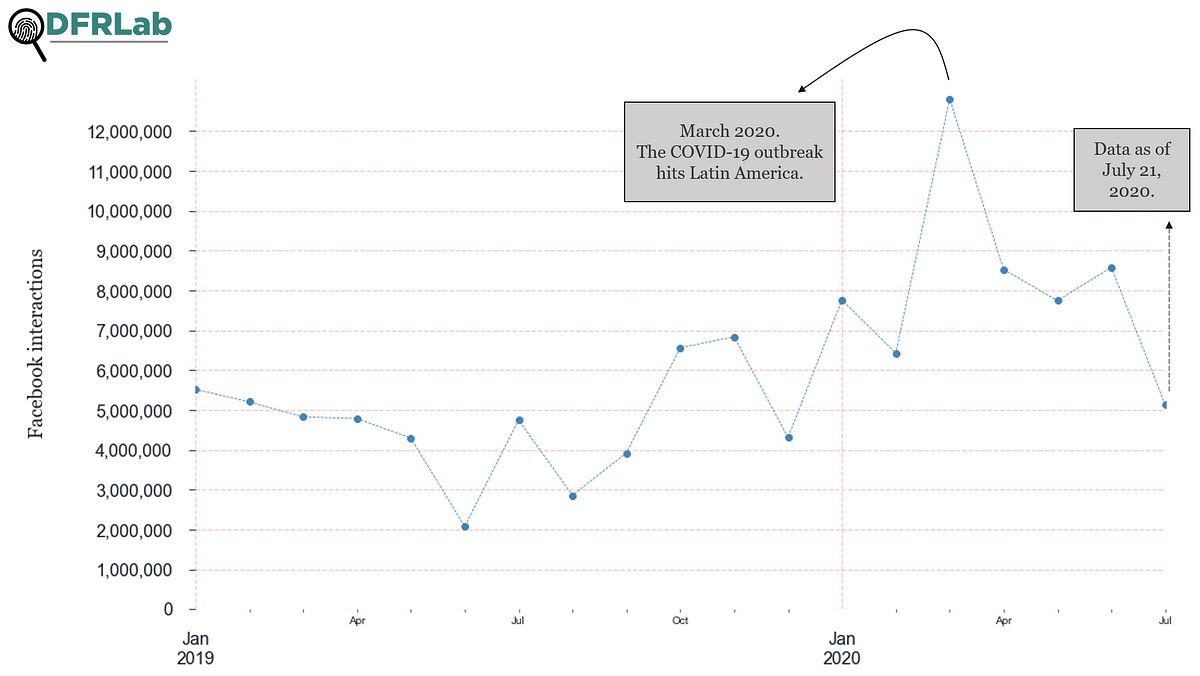
Co-occurring named entities
Using the dataset of RT en Español’s posts to its Facebook page, the DFRLab analyzed subheadlines of the nearly 46,000 links to its external website, actualidad.rt.com, and conducted a network analysis of co-occurring keywords, including locations, names of organizations, and people. This technique allowed researchers to identify recurrent connections among keywords in text analysis.
The results showed that actualidad.rt.com’s news subheadlines mostly included keywords such as “EE.UU.,” the standard abbreviation for the United States in Spanish; presidente (“president”); “Washington;” “Donald Trump;” “Gobierno” (“Government”); “Russia;” and Venezuela.

These findings indicate that news links shared by the Facebook page RT en Español regularly focused on the United States rather than other countries in the Latin American region. Followed by the U.S.-related keywords, Russia was the most included entity location in actualidad.rt.com’s subheadlines.
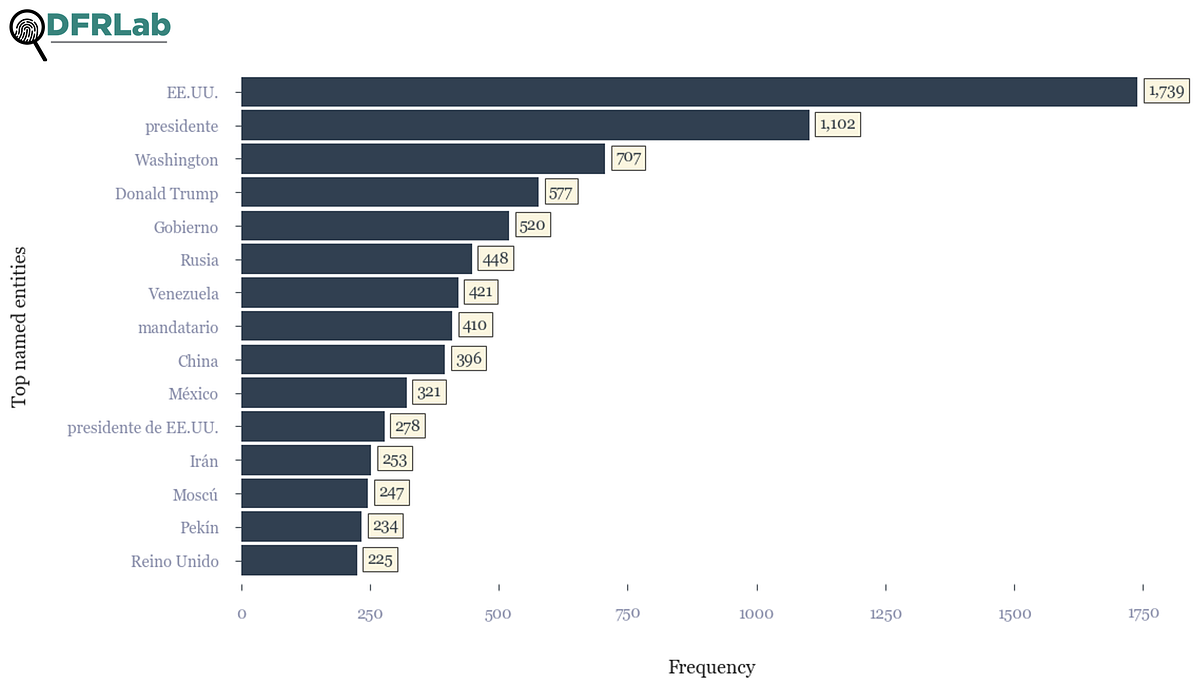
According to the top 15 named entities included in actualidad.rt.com’s news articles’ subheadlines, the DFRLab found more than 6,300 links shared on Facebook by RT en Español between January 2019 and July 2020.
The investigation found that, although the United States (“EE.UU.”) was the most co-occurring keyword included in subheadlines, the keyword “Venezuela” received, on average, more interactions, including shares, likes, and reactions.
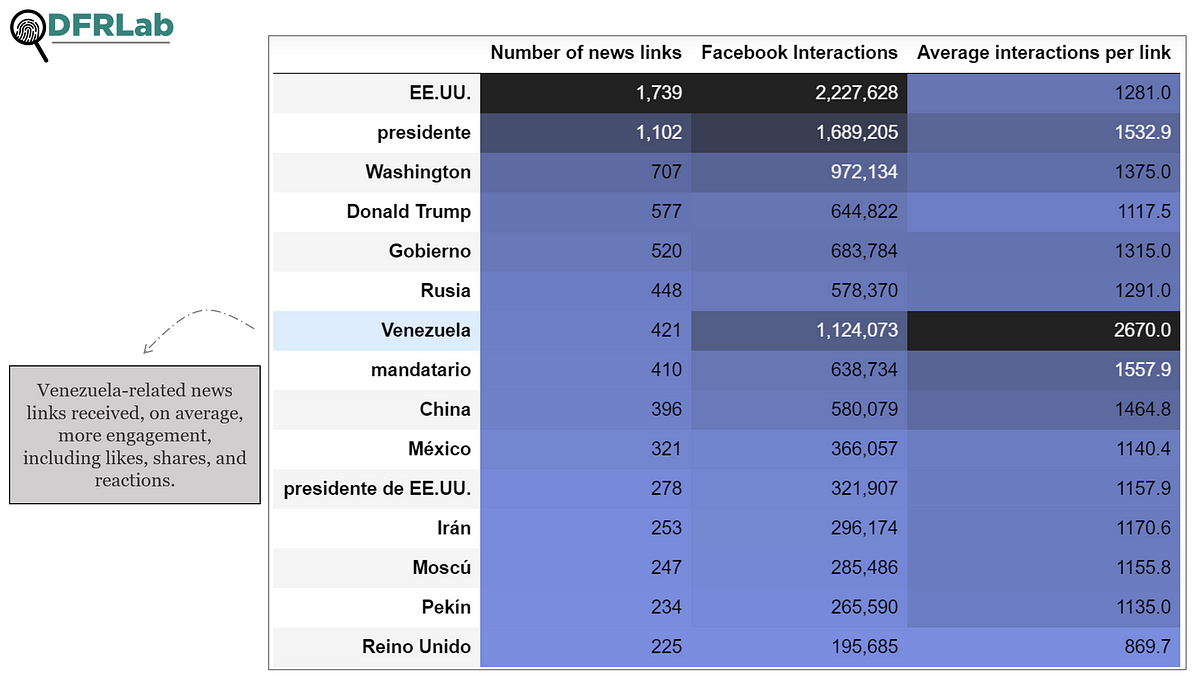
The most connected keywords to “EE.UU.” were “Donald Trump,” “presidente” (“president”), “China,” “Mandatario” (“Ruler,” often used to specify a world leader or president), and “Contra” (“against”), which in turn was connected to “Venezuela” and “Iran.”

Coordinated link sharing among Facebook assets
The DFRLab used the CooRnet package, which allows researchers to explore Facebook assets engaging in coordinating link-sharing behavior, based on a time threshold that identified which of the same links were shared by different pages or groups within an unusually short period of time.
Based on actualidad.rt.com’s news links, the investigation identified more than 1,000 accounts sharing such links within two seconds of difference. Although, the Facebook page RT en Español has increased in popularity, as mentioned above, the link-sharing behavior can indicate what Facebook groups or pages engage the most with actualidad.rt.com’s content in Latin America.
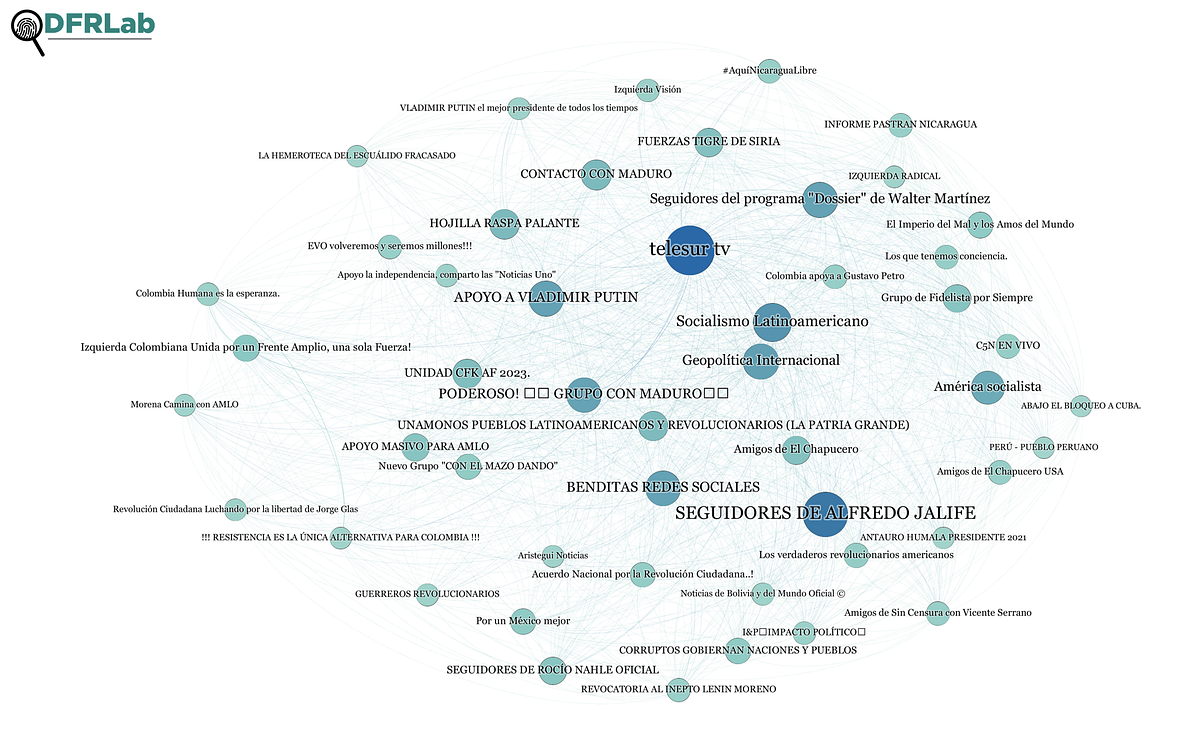
One of the Facebook assets that engaged the most was the Maduro regime-backed outlet TelesurTV, followed by groups supporting Vladimir Putin, former Bolivian President Evo Morales, the “Colombia Humana” left-wing movement, and Syria’s Bashar al-Assad.
The most active coordinated Facebook assets, determined by the number of shares rather than the degree of connection, included groups supporting former Ecuadorian President Rafael Correa, who is popular with the left in the region.
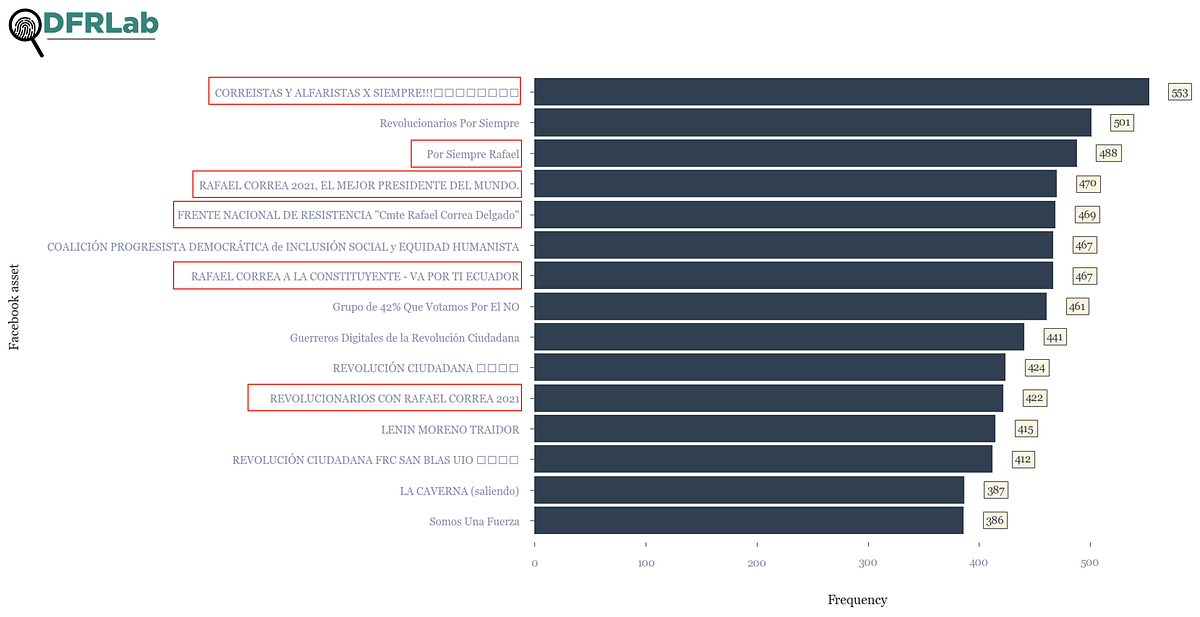
Twitter followers
The DFRLab confirmed that most of the Twitter followers with set location on their profiles mainly included Venezuela, Mexico, Colombia, and Argentina, indicating that RT’s Spanish-language content is more popular in these countries, as mentioned above.
By July 27, @ActualidadRT, RT’s official Twitter account in Spanish, had nearly 3,513,000 followers. Venezuela was the most popular location among the follower profiles to which the DFRLab had access. The DFRLab was only able to collect information on 3,512,132 of the follower accounts, as some were not retrieved by Twitter’s API due to individual user privacy settings.
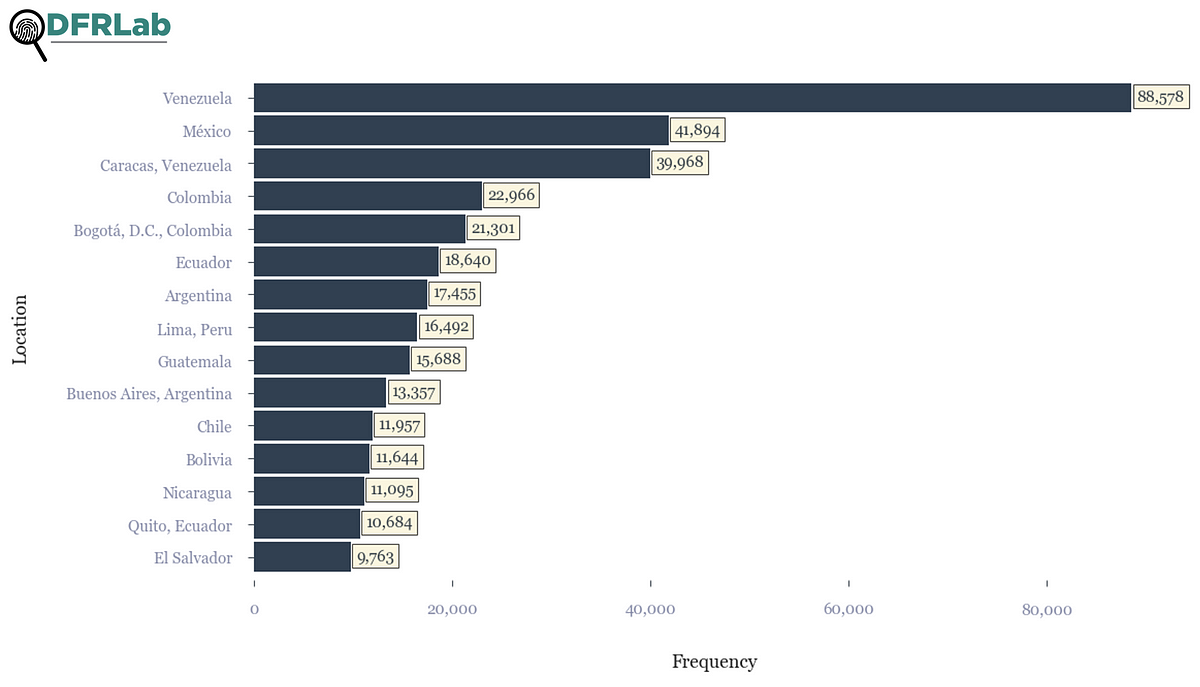
The DFRLab also analyzed the account creation dates using a similar approach as the New York Times’ Follower Factory article, which examines whether an account has purchased fake followers. The analysis’ criteria consisted of whether the analyzed account, in this case @ActualidadRT, had concentrated clusters of followers that joined on Twitter and followed it around the same time.
This analysis can be shown by creating a scatter plot graph, allowing researchers to map two different variables: in this case, followers’ creation dates and the follower count of the analyzed account.

According to this analysis, the DFRLab did not find many clusters of followers that both joined Twitter and that followed @ActualidadRT around the same time. The DFRLab did find, however, that @ActualidadRT had nearly 1 million followers by 2016, including a consolidated group of accounts that joined Twitter in 2010 and, to a lesser extent, a second, smaller group that joined in 2014.
The DFRlab was unable to find any evidence, however, of whether @ActualidadRT had grown in followers via inauthentic means, which would cast doubt on the effectivity of the Kremlin’s efforts to reach a broader audience in Latin America.
Although the popularity of RT in Latin America is undeniable, its increase in page likes on Facebook has been particularly dramatic during the COVID-19 outbreak. It is apparent that the Kremlin’s interest in the region as a means of indirectly influencing — and intentionally diminishing the relative power of — the United States remains strong and is ongoing.
Esteban Ponce de León is a Research Assistant, Latin America, with the Digital Forensic Research Lab.
Follow along for more in-depth analysis from our #DigitalSherlocks.

